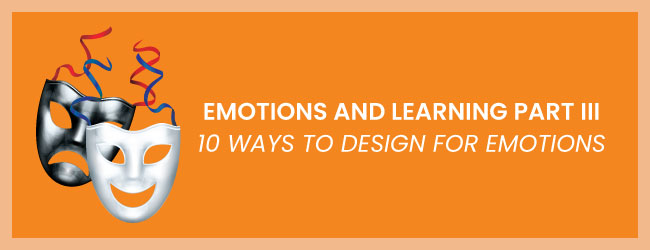.
It’s quite clear from research on emotional design for learning, that we can generate connections using the right instructional strategies and creative treatments. These have the potential to facilitate learning and performance.
This is the third article in the series on emotions and learning. If you’d like some background on this topic, read Emotions And Learning: Part I and Part II. Now let’s jump into some practical approaches to emotional design for learning.
1. Acknowledge emotions
This most straightforward and direct approach is under used in online learning. The idea is simple: to speak to the emotions, speak to the emotions. Acknowledge how learners might feel about the subject matter or the learning experience itself. Try framing the purpose of a course in emotional terms. This might mean telling the audience how a program will help them become more effective, more competent, or enable them to help others.
You might ask learners to think about how a scenario made them feel, or how a character may have felt. Allow learners to respond to questions about emotions in an end-of-course survey. The bottom line is this: adult learners have a wide range of life experiences, much of which is associated with emotions. They bring this emotional dimension to the learning environment so it deserves acknowledgment.
2. Respect the audience
People appreciate being valued and respected. This is one way to generate positive emotions during a learning event. How can we do this when all we have is electrons? Avoid a tone of condescension or superiority in on-screen text, scripts and live webinars. Write feedback that provides helpful information and is phrased in an encouraging way.
Ensure the instructional level is appropriate for the audience. If the content is too basic for an experienced audience, it implies we don’t care about their time. If it’s too challenging, it implies we don’t know them well enough.
3. Design for social interaction
Humans evolved to read signals from each other, often through emotional channels. Using collaborative tools and social media can help learners build relationships, cooperate on tasks, and provide support and feedback to each other.
If you design for social interaction, consider providing guidelines to make the experience more meaningful. For example, if group members are reviewing each others work, encourage them to offer detailed explanations rather than superficial comments like, “Nice work.” See Using Social Media for Learning for more on the social approach to learning.
4. Use principles of aesthetic design
The visual design of an online learning environment can impact the learner’s emotional response to it. You can leverage the human capacity for aesthetic appreciation by ensuring your courses are well-designed. In one study that examined emotions and multimedia learning, the authors concluded,
“There is significant effect of emotions on … [the participants’] transfer test, mental effort investment, as well as level of satisfaction. It also indicates that positive emotions can be generated by the instructional design that may be able to affect learners’ experience and performance. The study implies that positive emotions should be considered as important factors in instructional design.” — Eunjoon Um et. al.
Even if you are not the graphic designer, you can provide ideas and feedback on the layout, colors and type for a look and feel that will induce positive emotions.
5. Make it easy to use
Don’t let the technology or user interface get in the way of learning. The tools of learning should be as transparent as possible to the whole experience. When technology is easy to use, it can have a positive impact on the learner’s affect. Research shows that people notice the dynamics of their own mental processing and are sensitive to the resulting feelings of ease or difficulty in usability.
Some things you can do are: avoid slow downloads, write clear user interface instructions, let learners know what to do on every screen and adhere to common user interface conventions, when possible. Most users have a mental model of how an online program should work. Consider user friction and frustration if your course course breaks the mold for no apparent reason. If you’re interested in user interface design, see User Interface Design For Learning and Writing Microcopy.
6. Generate emotion through surprise
Evoke emotional responses by adding unexpected elements to your courses. When things move along at a steady pace, brain activation also remains steady; but when a surprising event occurs, the brain registers a jump in activity.
What about letting learners fail at their first try in solving a problem, if it can be framed as a learning experience? For some, the frustration of moderate failure can increase motivation for success.
What if an action resulted in an unexpected consequence? Why not avoid the linear mindset and allow exploration and discovery? You can provide humor in an unexpected moment or add an unusual twist to generic scenarios. When a learner encodes and stores information, an emotional reaction can serve as a mental index for locating the stored memory and corresponding information at a later date.
7. Immerse the learner in challenges
For an all-encompassing emotional experience, consider designing a learning event in an immersive environment. The realism and authenticity of games, virtual events and problem-solving challenges in an exploratory learning environment may simulate emotions one would experience in the non-virtual world. In addition, the ability to role-play and problem-solve through avatars is the ideal environment for emotional arousal while learning.
8. Tell stories
People are hard-wired for telling and listening to stories. They’re an age-old device for transferring knowledge and sharing information and values. Stories have a way of touching the emotions, because people perceive their own and others’ lives in a narrative form.
The narrative device is effective in case studies, interviews, simulations and role-playing scenarios. Stories make content more memorable because their authenticity adds detail and emotion to content. See How to Write Compelling Stories.
9. Use emotionally charged visuals
Both pleasant and disturbing pictures elicit a physical response in the body and speak directly to emotional centers in the brain compared to neutral pictures. Images of facial expressions and dramatic gestures are arouse emotional reactions and have similar interpretations across many cultures.
When instructionally appropriate, emotional pictures are an effective way to pique curiosity, gain attention and engage the audience because they evoke emotion. Does this photo on the left evoke an emotional response in you?
10. Evoke Memories
In the book, Emotional Design: Why We Love (or Hate) Everyday Things, Donald Norman points out that people build attachments to objects that have a significant meaning. This is typically because a person associates the object with emotional memories. You can allude to significant personal memories of your audience through common significant objects or by using analogies and metaphor in an effort to help learners connect with the content.Memories from childhood, times of fear or frustration, family celebrations and romantic love are all possible avenues for reaching out.
Conclusion
Remember that learners have a rich emotional history. Let’s not treat them like containers for depositing information.
Your comments, additions and feelings are welcome. Use the comment form below.
Related Articles:
- Aesthetics and Human-Computer Interaction (Research by Noam Tractinsky)
- Um, Eunjoon et. al., The Effect of Positive Emotions on Multimedia Learning
- If it’s easy to read, it’s easy to do, pretty, good, and true

Leave a Reply